Original author: Chen Mo cmDeFi
Core idea: Farcaster is a decentralized social media protocol that provides an open and composable social layer for developers, creators, and ordinary users.
The user level focuses on privacy protection and autonomous control, the protocol level focuses on open source and no permission required, and the product level advocates mini-program level interactivity, directly accessing a variety of services and applications in social media posts through Frames.
-
Decentralized architecture: does not rely on a central server and runs on the blockchain.
-
User control: Users have full control over their data and social graph, and they retain their identity even when applications are restricted.
-
Open source and permissionless: Anyone can access Farcasters API or application to build new applications.
-
Composable: Provides a platform-level social layer that allows applications to be combined and support access using a unified social identity.
-
Hybrid architecture: Combining on-chain and off-chain systems improves the efficiency and responsiveness of the system.
-
Frames feature: allows users to embed small applications in posts to enhance interactivity and user experience.
case analysis
Currently, SocialFi has two main directions:
-
Financialization – Friend tech
-
Original Layer Renovation – Farcaster
Farcaster is essentially a transformation of the original layer, which is closer to the concept of Layer. Therefore, it is possible to build financial services based on Layer and can derive more and broader application scenarios.
Farcaster is implemented through a hybrid architecture of on-chain + off-chain. Key information such as user identity and keys are processed on-chain, and storage, verification and propagation of content are processed off-chain. For example, Alice can create a message Hello bob and sign it with her key. Messages are stored on server nodes called Hubs. Each Hub stores a copy of the entire network. These Hubs form a new social consensus layer. Users can publish a message to a Hub, and the message will be propagated to the entire network within a few seconds.
On-chain part
Farcaster’s on-chain elements mainly consist of smart contracts, which run on Ethereum’s Layer 2 (Optimism). These contracts handle some core functions, including:
-
ID Registration: Generate a key pair associated with the new user’s Ethereum address to ensure the uniqueness and security of the identity.
-
Storage registration: manage the allocation of user data storage space and annual fee collection to ensure reliable data storage.
-
Key Registration: Manages users’ public and private keys, allowing users to grant and revoke control of their accounts for secure message signing and authentication.
Regarding storage registration, it is equivalent to the concept of buying space to post. Farcaster accounts must pay rent to keep their messages on the Farcaster network. The purpose of collecting rent is to prevent users from sending spam messages to the network. In other words, the threshold for using Farcaster is to pay 5-7 US dollars per year. In the early days, this may be a setting that is not very friendly to ordinary users, but it is also a way to maintain efficiency and performance when the network is not robust enough.
Off-chain part
Farcasters off-chain elements include a group of servers called Hubs, which run on traditional hardware and are responsible for processing data operations that do not require on-chain confirmation to speed up response and reduce transaction costs. Specific functions include:
-
Message processing: Hubs are responsible for receiving, verifying, and storing Casts (content published by users) from users. They check whether the signature of each message is valid and whether it matches the identity information registered by the user on the chain.
-
Data synchronization and propagation: Once a message is verified, Hubs store the message locally and synchronize it with other Hubs in the network to ensure data consistency and reliability.
-
Performance optimization: By processing a large amount of data interactions off-chain, Hubs can significantly reduce the need for on-chain transactions, thereby reducing latency and costs. This is especially important for social networking platforms because they need to handle a large number of real-time interactions.
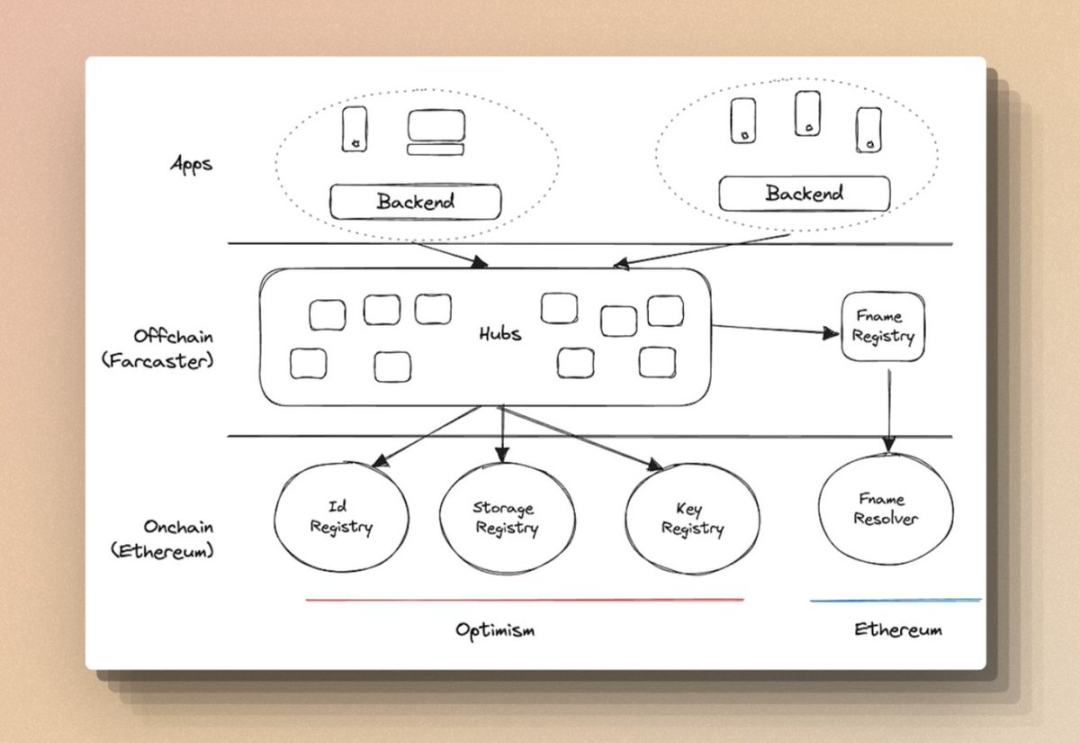
Social Optimization
The social relationships and interactions of users on Farcaster are optimized in many ways through this hybrid architecture:
-
Autonomous identity and key management: On Farcaster, users create a unified identity on the chain (through the ID registration contract), which is associated with their Ethereum address and the generated key pair, and through key management on the face, users are allowed to securely manage access and authorization to their accounts, without relying on any third-party services, ensuring that only the user can control the use of their identity. So in traditional social software, your username being officially recycled will never happen.
-
On-chain and off-chain data isolation: By processing core security functions (such as authentication and authorization) on-chain and non-sensitive social interaction data (such as messaging, social graph construction) off-chain, Farcaster is able to provide a fast application experience while maintaining user privacy.
-
Decentralized storage: The way user data is stored in Farcaster is decentralized, meaning that the data is not stored on a single server, but is protected through a distributed network. This increases the datas ability to resist censorship and attacks, and at the same time this will establish a new social consensus layer. As this consensus becomes stronger, storage will become more decentralized, providing better underlying support for Farcaster as a whole. Similar to Chainlinks establishment of a distributed oracle network, as its DON nodes become more mature, the security and stability of the entire oracle will also be greatly improved.
-
Autonomous control over data access and sharing: Farcaster is able to achieve precise control over data access rights through smart contracts. Users can set who can see their social activities and personal data. These settings are directly embedded on the chain and executed by smart contracts. This approach allows users to fully control the sharing level of their information, and different applications can access users social graph data based on user authorization.
-
Cross-application interoperability and composability: Since Farcaster provides APIs and developer tools, third-party developers can create applications that are compatible with Farcaster identities, and users can use the same identity to interact between different social media applications. This is similar to the embedded interactivity of WeChat mini-programs, which is equivalent to using the unified identity of WeChat account to log in to different applications, and Farcasters permissionless entry method will bring a richer mini-program ecosystem.
In the recent period (May 2024), Farcaster reached a new high in daily active users.
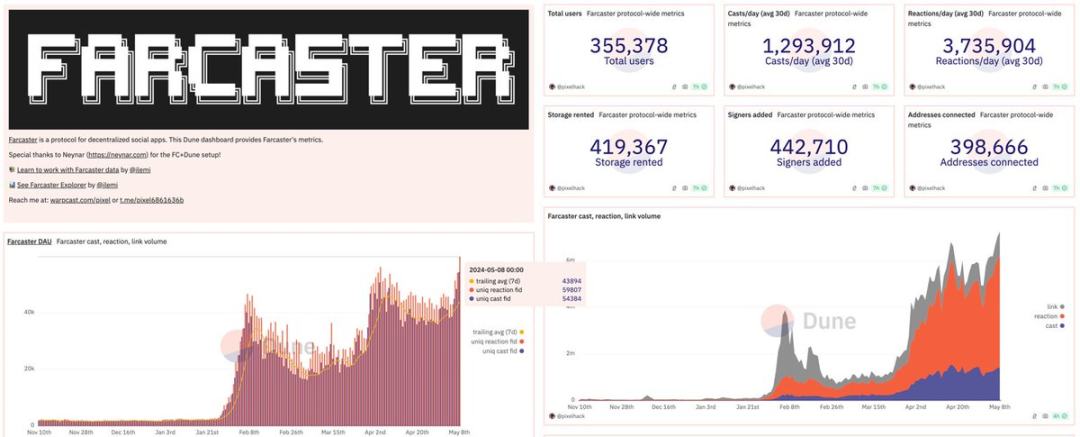
Frames
Frames are essentially small applications embedded in Farcaster posts, which make posts more than just static content displays, but can become interactive platforms. Users can access various features and services directly in social media interactions without leaving the Farcaster platform.
For example:
-
NFT Interaction: Users can mint, display or trade non-fungible tokens (NFTs) through Frames. For example, an artist can display the NFT of their artwork directly in a post and provide the option to buy or bid.
-
Games: Developers can embed simple games directly into posts, allowing users to play them while browsing social media.
-
Content subscription: Allow users to subscribe to newsletters or other media content. Content creators can provide a dedicated subscription button through Frames.
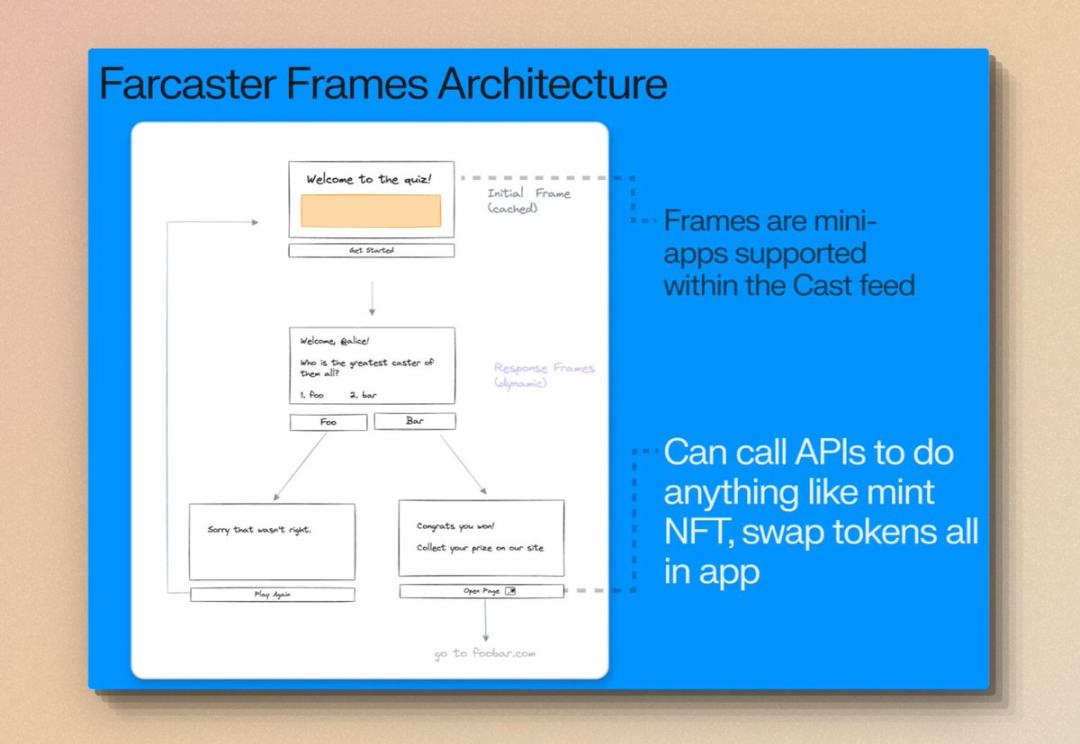
Asset issuance
In a sense, the new asset issuance method born on Farcaster breaks through the concept of traditional SocialFi. The Fi in SocialFi usually designs an economic model for the social project itself to motivate the participation of creators and users. For example, Friend tech creates revenue for creators by tokenizing the creators themselves and the content.
Farcasters Layer attribute not only completes the underlying transformation of Social, but also provides a new way of asset issuance, which completely changes the attribute of Fi in the traditional SocialFi concept. It does not design a complex financial structure for itself, but provides this openness to the community and developers, becoming a launchpad for community tokens, community culture, and community ecology.
At the same time, although Farcasters user threshold is not conducive to the expansion of the user base, it has correspondingly achieved a very high user purity. Basically, more than 90% of daily active users come from Crypto native users.
Ultimately, Farcaster provides a good foundation for the subsequent operation, promotion and community accumulation of the project, from providing an asset issuance environment to relying on the accumulation of its own high-purity users.
Ecological Economy-$DEGEN
The token $DEGEN is an extremely special token in the Farcaster ecosystem. It is not officially issued, but a community-driven memecoin. It has become the first token of the Farcaster community and is building surrounding applications and ecosystems around DEGEN.
-
Sharing and Rewarding: DEGEN can be used to reward content creators in the community, promoting content sharing and community participation.
-
Minting NFTs: On platforms such as Zora and Highlight, users can use DEGEN to mint NFTs, thereby increasing their liquidity in the art and collectibles markets.
-
Trading: DEGEN is used for various applications and in-game transactions, such as Drakula and Bracket game.
-
Community Building: DEGEN is also used to support and fund community projects, such as development and operations on Degen L3.
Drakula: An onchain short video app similar to TikTok, where users can reward and interact with content using DEGEN.
Clubcast: An onchain platform similar to Patreon that allows content creators to provide exclusive content through token-gated channels.
ConsenSys: When ConsenSys faced warnings from the SEC, its founder Joseph Lubin collected DEGEN on Farcaster and stated that any DEGEN tips received would be used to defend the Ethereum ecosystem. A large number of crypto community members participated in the rewards to show their support.
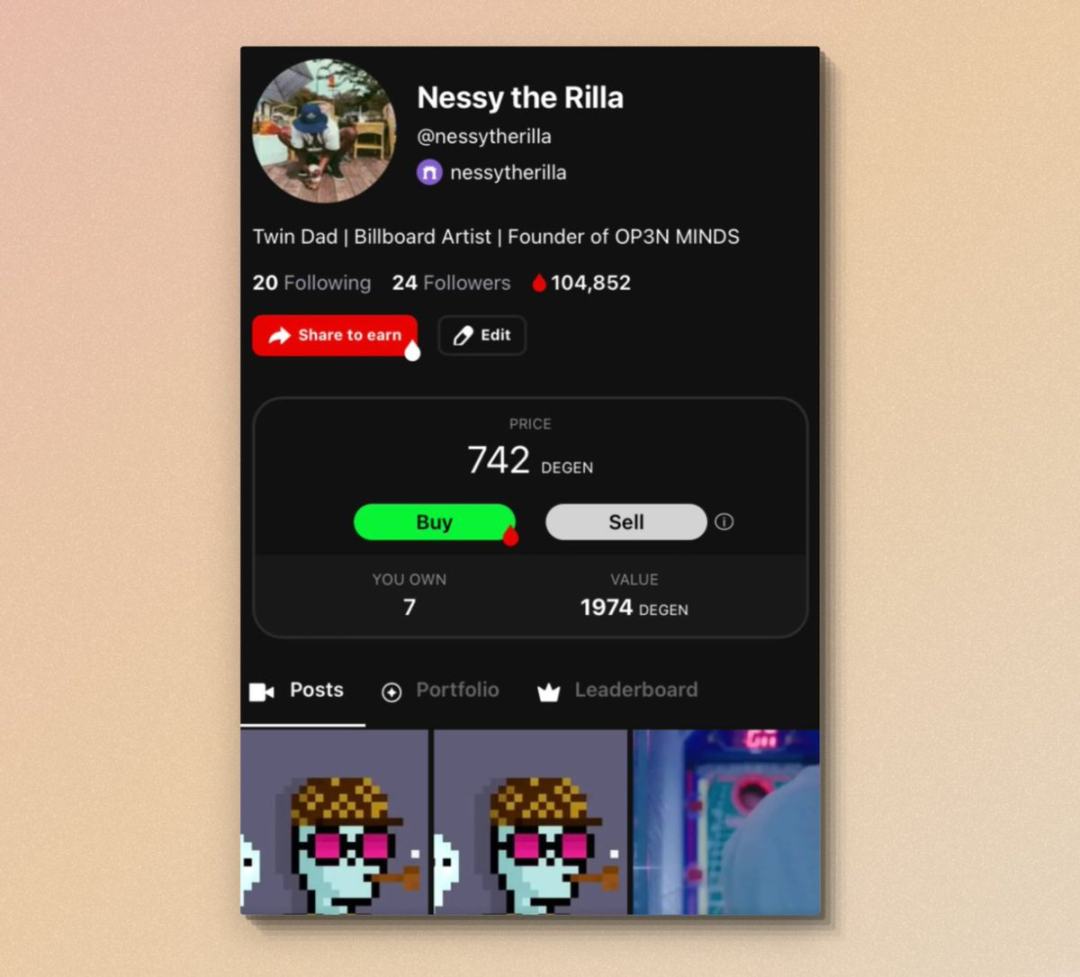
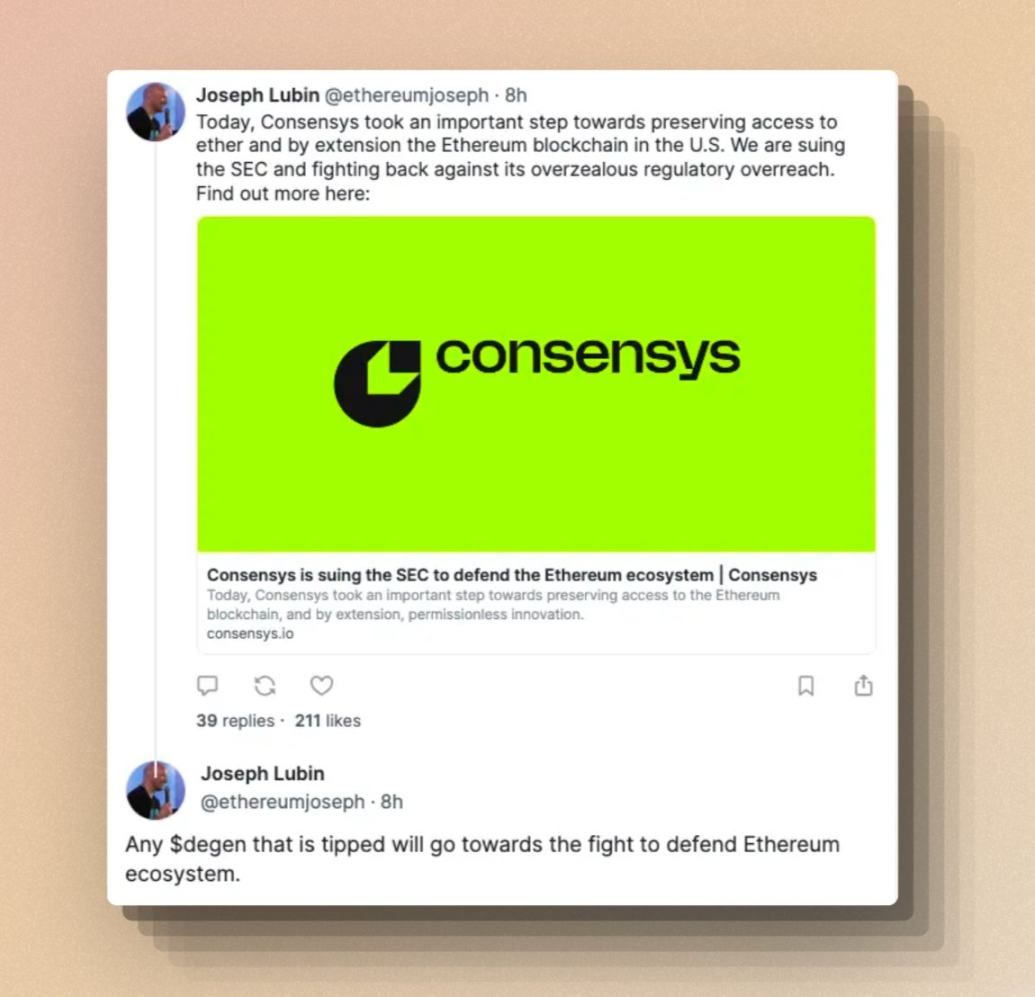
Eco-Economy- Warps Points
In the Farcaster ecosystem, Warps Points is an important component designed to incentivize and reward users’ social interactions and participation. As an internal points system, Warps Points not only increase the interactivity of the platform, but also provide an incentive mechanism to encourage users to actively participate in community activities.
1. How to earn points
Active participation: Users can earn Warps points for active interactions on Farcaster, such as posting content, commenting, sharing, etc. This design encourages users to use the platform more frequently and share valuable content.
Completing tasks: Farcaster may set specific social tasks or challenges, and users can earn Warps points after completing these tasks.
Community Contribution: Users who contribute to the community, such as content creators or technical supporters, can earn Warps points through community recognition or direct rewards.
2. How to use points
Paying Fees: Users can use Warps Points to perform certain activities on Farcaster, such as participating in certain social events or purchasing social features.
Start a new channel: Users can use their points to create new social channels, which may be organized around a specific topic or interest.
Gift Points: Users can gift points to other users as a reward for their content or interactions.
3. Points management and issuance
The Warps points system is centrally managed by the Farcaster team, which means that the issuance, distribution and rules of points are formulated and controlled by the platform administrator. Therefore, Warps is not equivalent to tokens, but a functional point within the Farcaster ecosystem.
Open and composable
Farcaster is essentially a large ecological database on-chain + off-chain. Based on these data, any form of front-end can be built to provide users with different usage experiences. This has several advantages:
-
Decentralization: even if one frontend is restricted, it will not affect users’ access to other frontends.
-
With diversified ecology, developers can focus on developing front-ends in a certain field for users to use, such as article content platforms, live broadcast platforms, WeChat Moments platforms, etc. At the same time, the combination of applications will also provide unlimited imagination for the ceiling of Farcaster ecology.
Currently, Warpcast is the most popular and used front-end, and its experience is very close to Twitter, but other front-ends are also becoming more and more popular, such as
-
Bountycaster: Serves as a job board where users can post or complete tasks in exchange for a bounty or monetary reward.
-
Unlonely: Focuses on live streaming, providing users with a platform for real-time interaction and content sharing.
-
Kiosk: A new Farcaster client that recently received $10 million in funding from a16z and Electric.
Advantages and Challenges
The challenge of the SocialFi track is that it is usually impossible to answer the question of why stay?, because the Social in the Web3 world has inherent disadvantages in experience and threshold compared to Twitter and WeChat. Therefore, the previous solution was to incentivize users in the name of Fi and to attract creators to join. In essence, it is a solution to tokenize the value of creators to help them realize their value. The problem with this solution is that it throws issues such as product threshold, experience, and traffic to the creators. Because you can make money, you have to attract your fans to interact on the platform.
Farcaster is more like a Social Layer, on which can be Fi, NFT, music, games and all other developable applications, and this part is completed by developers, so this is an ecosystem led by developers, co-built by the community, and participated by creators.
What are Farcasters advantages?
To be honest, the idea of Farcaster is not new, but its advantage is that it has already completed the initial user sedimentation and retained a large number of Crypto native users. These users have really played and the user activity data this month has also reached a new high. At present, Farcaster has not issued its own tokens, but it has basically achieved the commonality + attraction of creators, developers, and ordinary people, rather than relying solely on Fi to retain users.
What are the challenges facing Farcaster?
From the perspective of the Chinese region, the entry fee for registration and storage currently needs to be paid by credit card, and does not support crypto-native payment methods. This is a threshold for the Chinese user group. If it can be paid directly through cryptocurrency, it will be more beneficial to the expansion of the user group. In the long run, the growth of the number of users will test the carrying capacity of Hubs and the social consensus of the Hubs network. From an ecological perspective, how to form a positive cycle in content is very critical, because the characteristics of social products are usually based on visual elements, and any content (good/garbage) will be very intuitively presented to users, so the spam in Social has a more serious negative impact on users than the spam code on the smart contract network. For example, N Web3 Social products were born in the past, which were full of pornographic and fraudulent information, gradually lost control and died. However, the characteristics of decentralization are often not to intervene in the production of content through human intervention. Therefore, how to balance and form sustainable development on this seemingly contradictory point is also a challenge in the future. Long-term and continuous positive cycle is the key to changing user habits.
How did Farcaster break out of the circle?
On the issue of going out of the circle, Farcasters current task is to attract and retain Web3 users on Twitter. For creators, the autonomous control of accounts is increasingly valued, especially those who have experienced Twitters account suspension, who can more deeply understand the meaning of decentralization and autonomous control. At this stage, Farcaster is not a product like NFT Summer that can attract outsiders to settle in and consume. It is precisely its target that is users in the circle. At the same time, for users in the circle, its openness, developability, and composability perfectly fit the spirit of encryption. Pulling users in the circle to the Social Layer belonging to Web3 is Farcasters going out of the circle.
This article is sourced from the internet: In-depth analysis of Farcaster: How to reshape SocialFi?
Related: Markus Thielen Says Forget the Idea of the Ethereum Flippening Bitcoin
In Brief Markus Thielen doubts Ethereum can surpass Bitcoin, cites weak fundamentals. Thielen criticizes Ethereum’s late upgrades and declining market influence He also highlights regulatory issues and poor performance in stablecoin market. The crypto community has long debated whether Ethereum (ETH) might one day surpass Bitcoin (BTC) in market capitalization—a scenario often referred to as “the flippening.” However, Markus Thielen, head of research at 10x Research, remains skeptical. According to Thielen, Ethereum’s weak fundamentals and recent performance trends strongly suggest that Bitcoin will maintain its dominance. How Ethereum Has Been Lagging Behind Often called digital gold, Bitcoin has solidified its role as a hedge against inflation and a key asset in the portfolios of “sovereign individuals” worldwide. This identity was reinforced in 2017 when Bitcoin developers decided to maintain a…






